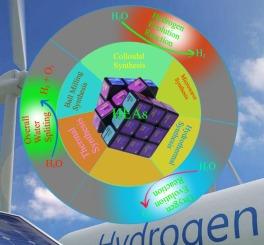电化学水分解用高熵合金的最新进展:材料、合成及应用
IF 5.9
3区 工程技术
Q1 CHEMISTRY, MULTIDISCIPLINARY
Journal of Industrial and Engineering Chemistry
Pub Date : 2025-05-15
DOI:10.1016/j.jiec.2025.05.032
引用次数: 0
摘要
高熵合金(HEAs)是一类由多种主要元素组成的材料,能够形成均匀的固溶体结构,同时防止相分离。它们的独特性质,即合金效应、化学无序性、晶格畸变和鸡尾酒效应,使它们在催化和储能应用中具有重要的前景。HEAs具有丰富的活性位点和较高的结构稳定性,近年来作为电化学水分解的功能材料,特别是在析氢反应(HER)和析氧反应(OER)中受到了广泛的关注。通过添加活性过渡金属如Ni、Cr或Fe,可以进一步提高其电化学性能。本研究首先综述了各种合成HEAs的技术,包括水热合成、熔体纺丝、机械合金化、微波烧结、电镀、碳热冲击合成、电弧熔炼和磁控溅射,并强调了它们在调整催化剂结构和表面性能方面的作用。然后详细分析了HEAs的理化性质,并对其在HER和OER中的电化学行为进行了全面的讨论。特别强调了合理设计hea基电催化剂的先进策略。本文章由计算机程序翻译,如有差异,请以英文原文为准。

Recent advances in high entropy alloys for electrochemical water splitting: Materials, synthesis, and applications
High entropy alloys (HEAs) are a class of materials composed of more than one major element that enable the formation of homogeneous solid solution structures while preventing phase separation. Their unique properties, namely alloying effects, chemical disorder, lattice distortion, and cocktail effect, give them significant promise in catalysis and energy storage applications. In recent years, HEAs have attracted attention as functional materials for electrochemical water splitting, especially in hydrogen evolution reaction (HER) and oxygen evolution reaction (OER), due to their abundant active sites and high structural stability. Their electrochemical performance can be further enhanced by adding active transition metals such as Ni, Cr, or Fe. This study first reviews various synthesis techniques for HEAs, including hydrothermal synthesis, melt spinning, mechanical alloying, microwave sintering, electroplating, carbothermal shock synthesis, arc melting, and magnetron sputtering, and highlights their roles in tailoring the structural and surface properties of catalysts. It then analyzes the physicochemical properties of HEAs in detail, followed by a comprehensive discussion of their electrochemical behavior in HER and OER. Particular emphasis is placed on advanced strategies for the rational design of HEA-based electrocatalysts.
求助全文
通过发布文献求助,成功后即可免费获取论文全文。
去求助
来源期刊
CiteScore
10.40
自引率
6.60%
发文量
639
审稿时长
29 days
期刊介绍:
Journal of Industrial and Engineering Chemistry is published monthly in English by the Korean Society of Industrial and Engineering Chemistry. JIEC brings together multidisciplinary interests in one journal and is to disseminate information on all aspects of research and development in industrial and engineering chemistry. Contributions in the form of research articles, short communications, notes and reviews are considered for publication. The editors welcome original contributions that have not been and are not to be published elsewhere. Instruction to authors and a manuscript submissions form are printed at the end of each issue. Bulk reprints of individual articles can be ordered. This publication is partially supported by Korea Research Foundation and the Korean Federation of Science and Technology Societies.

 求助内容:
求助内容: 应助结果提醒方式:
应助结果提醒方式:


